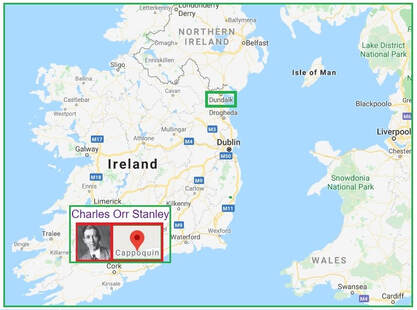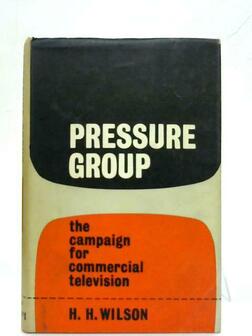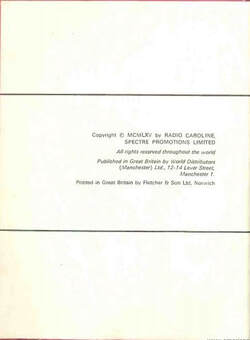|
Prince Charles explains 'pebble theatre'.
|
PEBBLE
|
|
Don Pierson [right] explains how a young Prince Charles made a request to join the Radio London fan club. |
|
|
Prince Charles explains 'pebble theatre'.
|
PEBBLE
|
|
Don Pierson [right] explains how a young Prince Charles made a request to join the Radio London fan club. |
|
 When Ireland and Radio Caroline are mentioned in the same breath, the anoraks assume that the focus is upon Greenore, near Dundalk, where the radio ship 'Caroline' was fitted out. Greenore being a property once owned by a building materials manufacturing company that was controlled by the father of Ronan from his home which was located nearer to Dublin, . But eyes should drift southwest on the map of Ireland to a place located between Cork to its south, and Waterford to its north. It is a very small town called Cappoquin and that is where Charles Orr Stanley was born in 1899 during the days when the British Crown still maintained control over the entire island. Charles parents were Protestants and his childhood friends who were Roman Catholics who taunted him with yells of "Proddy-woddy green guts".  Now for the important part that this man and his son John played in the creation of ITA, and the process that created Radio Caroline. You might think that his story is well documented, but it is not. What has been written about him in biographical format is the result of his grandson, Nicholas who organized the publication of a 2002 book called 'Radio Man'. It was authored by journalist Mark Frankland with the technical assistance from Garry Busey. When the Stanley family lost control of the Pye Group of companies in 1966, the Phillips company took over, and they all but erased the commercial and corporate history of the Pye Group. So Nicholas, the grandson of Charles and son of John, set about finding and collecting what information still existed, and then assembling it into a new collection. Where there were gaps, he began to fill them in by creating fresh interviews that he conducted personally. This is where the story of Radio Caroline enters the picture. However, there is a mystifying problem. Nicholas personally tracked down and found the man who was entrusted to bring the Radio Caroline project to life on behalf of his father John. That was a top secret project. The name of that man is Alan Bednall, and Nicholas interviewed him at his home in the village of Barton, which is just outside of Cambridge. Alan Bednall gave Nicholas several artifacts and an interview. But when it came time to hand his notes to Mark Frankland, Nicholas seems to have given him a 'doctored' version which said the opposite of what Alan Bednall told Nicholas Stanley. Alan Bednall never saw his artifacts again, and neither did he get a chance to proof read the final version of his interview, before it went to press. The published version of the interview makes no sense whatsoever, and the part about Radio Caroline occupies just one paragraph in the entire 'Radio Man' book, with its source left unattributed. Fortunately the typed copy of the original interview notes were discovered at a warehouse facility at Wroughton, which is in the English Borough of Swindon. A few blogs ago (on 3/31/2010), I explained the story behind this search and then the discovery of the original interview notes. Because I have previously covered this information in depth, I won't repeat it here, but you can read it at: Looking for 'key words' in boxes of words ... Charles Orr Stanley and his son John Stanley are only one part of the story that leads up to the creation of Radio Caroline. There are a lot of intertwined names of people who are now mostly unknown to the general public. Yet during the Nineteen Fifties, this assemblage of individuals played a big part in the creation of ITA, and then they mounted a major plan to get licences for nearly 200 stations waiting for commercial radio licences.  'Pressure Group' by H. H. Wilson and published in 1961, raised a storm in Parliament when it was discussed at length. It is an essential book for anyone who wants to understand how and why the Pilkington Committe came into existence. It wasn't just that there were nearly 200 commercial radio stations waiting to get licences, it was because one half of the Establishment wanted to roll back the powers of ITA and curtail the independence of its ITV commercial program contractor licences. The issue was 'American influence' due to their importation of programs and format scripts.  Another book that helps to show the inter-connectivity of these pressure groups in 1961 'Power Behind the Screen' by Clive Jenkins. Now this book is also of direct interest to anyone who has read any of the nonsense books about the start of Radio Caroline: because it offers clues about the person named Arthur Carrington. Arthur Carrington was introduced into the story to provide cover for ex-BBC and Marconi radio engineers who had worked on the transmission side of both Radio Caroline ships: mv Fredericia, and mv Mi Amigo. What is still not clear is why and how the name of Arthur Carrington came to be used at all. It now appears that there was a convoluted methodology wherein Carrington was approached to lend his name for this purpose because Carrington was being employed elsewhere by members of the loose cartel that were behind the project that emerged as Radio Caroline. It should also be remembered that Radio Caroline was the spin-off from Project Atlanta, and that a very hurried plan of action was thrown together beginning around September-October 1963 when the Radio Caroline spin-off began. The name of Arthur Carrington crops up in several items that were published by or about the birth of Radio Caroline. At first 'The Trio' wondered if there was such a person, and then they found references to him in a number of places - unconnected to radio broadcast engineering! But Arthur Carrington is credited by the bogus stories about the birth of Radio Caroline with several achievements that are in fact the documented work of employees belonging to the Pye Group of companies. Those details are to be found in the book 'Radio Man'. But Arthur Carrington was a Marconi employee whose specialty was television cameras! I suppose that it was not too difficult to attribute the first underwater cameras to Carrington, but that was revealed as being a totally fictitious and bogus claim within detailed text (with a picture!) in the book 'Radio Man'. Actually, quite a bit has been written about Arthur Carrington, and while I won't account for all of that here (it will be in the book 'Radio-Noir'), I will refer to a 1955 article in 'The Guardian' for Thursday, November 17, 1955. On page 11 an article is headlined: "More details of ITV Plans in North and Midlands." A sub-headline reads: "Some Programmes Shared with London." This article explains how: "A.B.C. Television, Limited the company which has been given the contract for supplying week-end programmes in the Midlands and the North by the I.T.A., expects to be on the air at Birmingham in February and in Manchester by the first week in May. .... No decision had been made yet in the case of Manchester, but it was likely that there too, a cinema would be converted into a studio building." The same article continued: "....Mr Arthur Carrington, formally of Marconi, is to be the head of engineering." Several other Carrington articles have come to light about his specialty in studio camera positioning and his related employment by Marconi. In other words, Carrington was not an employee of the Pye Group of companies, and we also know that he was not the counterpart of Alfred Nicholas Thomas, yet this is the misleading information that being published during 1965 in the name of Radio Caroline:  This fake information was published in 1965 by 'Spectre Promotions Limited', and we have come to know a great deal about that company from official government documents which are on file at the National Archives in Kew. Spectre is where the person of Ian Cowper Ross became seriously involved with feeding Ronan O'Rahilly with misleading (fake) stories. It also appears that for a very brief time Ian Cowper Ross was put on the Jocelyn Stevens' payroll in his advertising department. It seems that this is how he became assigned the job of speechwriter for Ronan O'Rahilly who served as the 'decoy duck' for Jocelyn Stevens. This same misleading (fake) information was then given to John Venmore-Rowland to use in his 1967 public relations book about Radio Caroline. When Alfred Nicholas Thomas retired in 1959 from the BBC, he went to work for the Pye Group of companies, and one of their projects was the equipping of the former lightship 'Lady Dixon' as a radio ship. That was for a station to be known by the call letters GBOK. The lightship was docked at Sheerness alongside a Pye company facility. But GBOK turned out to be a total fraud because its owner named Arnold Swanson, was a con man. Swanson's wife soon divorced and she exposed him as being a former vacuum cleaner salesman. Arnold Swanson later went to prison in Canada after being convicted in court of underage sexual activities. After his work on the GBOK project, A. N. Thomas, who had also been involved with Radio Veronica and its fledgling enterprise CNBC, then went to work with Allan Crawford on the second phase of his Project Atlanta. We also know that Thomas also worked with a U.S. citizen and radio engineer named Milan Leggett. He had been sent by Gordon McLendon on board the mv Mi Amigo when the ship left Galveston, Texas. During this same period of time, Leggett was also attached to a firm selling specialized transmitters of the kind used by secret spy agencies such as the CIA.
The masts on both mv Fredericia and mv Mi Amigo were constructed under the supervision of Wijsmuller by Harry Spencer from the Isle of Wight, but the antennas strung from both of their masts were both designed by another ex-BBC engineer named John Howard Gilman. Like Thomas, he had previous worked for Pye on the GBOK project. Gilman also had connections to the secret intelligence services. In the closing months of World War Two, Gilman headed-up a top secret mission to capture in-tact, the high power transmitter station used by 'Lord Haw Haw' which had broadcast from inside Germany. He was successful, in that he and the British Army team with him, were able to turn off Nazi propaganda and switch over as a new relay station broadcasting for the British government. Because the entire story of Radio Caroline has been wrapped in deliberate lies and distortions it is not surprising that Arthur Carrington was asked to lend his name as part of the smokescreen to imply that the work performed on the mv Fredericia, and the work performed on the mv Mi Amigo, were parts of two different projects. To make that lie work the two projects had to appear as rivals with two different people responsible for the engineering work. To simplify the fake story, Arthur Carrington was made out to appear as if he alone had become responsible for the entire engineering side of Radio Caroline. Whether Arthur Carrington ever had any connection to Radio Caroline is another question, but the common denominator in the lie seems to be the Pye Group of companies and John Stanley. Both mv Fredericia and mv Mi Amigo were two parts of one project. Even the Radio Caroline first shows were recorded in the studios of Allan Crawford on Dean Street, and it was his staff who trained the first Radio Caroline disc jockeys. Now it is possible to understand why Ronan O'Rahilly was hired as a 'decoy duck' to mislead not only the press, but the army of anoraks who now worship at the very mention of his name. What is very strange is that the tiny licensed entity now calling itself 'Radio Caroline', makes it very clear indeed that it is the work and property of one Malcolm Smith, and that neither he nor his small station owes anything to Ronan O'Rahilly. It was to overcome the convoluted story-line concerning a fake connectivity back to the year 1964, that the bogus work of Paul Rusling was created under the name of 'The Radio Caroline Bible'. As this blog progresses I will be adding more brief fragments about some of the many people involved with the 1964 project that eventually resulted in the offshore station called Radio Caroline. These names will later appear in a brief biographical index which can be accessed under the 'Biofrag' link at the top of this blog. This theme will continue in the next blog entry. NOTE: This entry was amended and expanded several times on 5/9/2020. Comments are closed.
|
Our team produced this free radio program for PCRL in Birmingham.
It was repeatedly broadcast on and after October 20, 1985. Click & listen! Blog Archive
August 2023
Copyright 2021 with all rights reserved.
|
Index |
Library |
|
